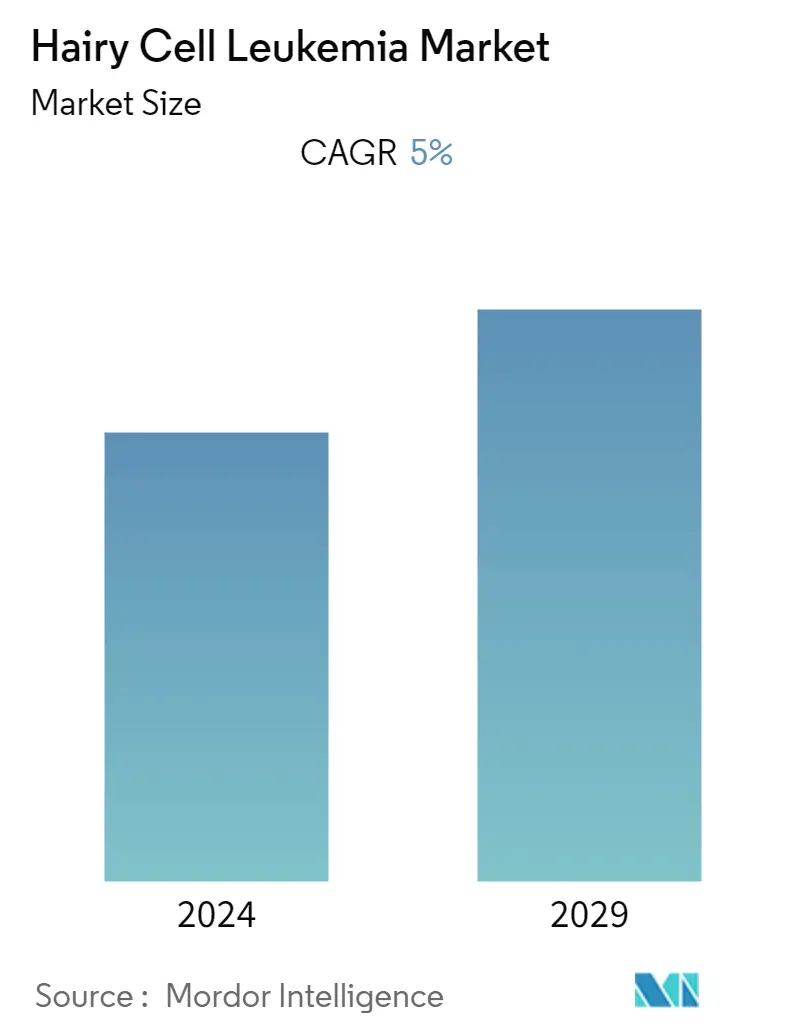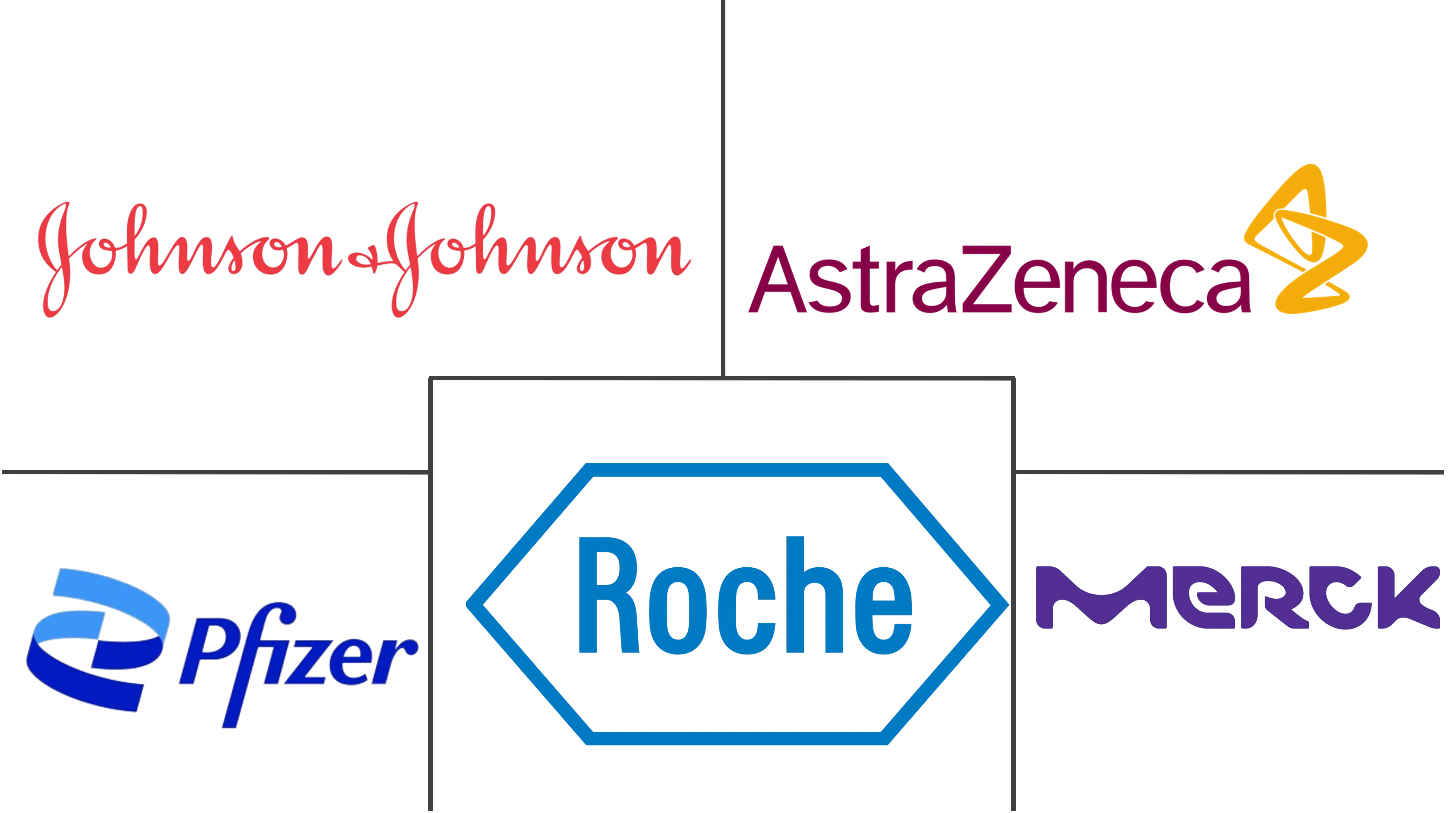Market Size of Hairy Cell Leukemia Industry

| Study Period | 2019 - 2029 |
| Base Year For Estimation | 2023 |
| Forecast Data Period | 2024 - 2029 |
| CAGR | 5.00 % |
| Fastest Growing Market | Asia Pacific |
| Largest Market | North America |
Major Players
*Disclaimer: Major Players sorted in no particular order |
Hairy Cell Leukemia Market Analysis
The hairy cell leukemia market is expected to grow at a CAGR of 5.0% during the forecast period.
The COVID-19 pandemic had a significant impact on the market studied. Cancer treatments such as chemotherapy and immune suppressants typically damage the patient's immune system. This weakened immune system of the target population is expected to create a risk of COVID-19 infection. Various studies have been conducted to determine the impact of COVID-19 on leukemia patients. According to a research article published in September 2021, chronic lymphocytic leukemia (CLL) patients are more susceptible to serious infections due to the immunodeficiency caused by the disease and its therapy, and COVID-19 continued to have a high admission rate even among consecutive and young early-stage CLL patients. However, with the restrictions released and treatment services resumed, the demand for leukemia treatment is expected to increase, driving market growth over the forecast period.
Certain factors that are expected to propel market growth are the growing burden of leukemia cases, the increasing diagnosis rate, and the growing geriatric population. In addition, the elderly population is at high risk of developing leukemia, which is also expected to increase the demand for effective treatment options, thereby increasing the demand for its treatment. For example, according to data published by the Mayo Clinic in 2022, hairy cell leukemia typically affects people in their 50s or 60s. In addition, as per the same source, men are more likely to be affected by hairy cell leukemia than women.
Furthermore, according to an article published in October 2021, it has been observed that chronic lymphocytic leukemia (CLL) is one of the most frequent kinds of leukemia, with an age-adjusted incidence of 4.9 per 100,000 people per year. As per the same source, only 9.1% of CLL patients are under the age of 45, and the median age at diagnosis is 70 years. Thus, all the aforesaid factors are expected to propel market growth over the forecast period.
On the contrary, the lack of awareness and limited health services in rural hospitals are expected to hinder market growth over the forecast period.
Hairy Cell Leukemia Industry Segmentation
As per the scope of the report, hairy cell leukemia is a type of blood cancer associated with the accumulation of abnormal lymphocytes. Overproduction and accumulation of hairy cells cause a deficiency of normal blood cells. The hairy cell leukemia market is segmented by therapy (chemotherapy and targeted therapy) and geography (North America, Europe, Asia-Pacific, the Middle East and Africa, and South America). The market report also covers the estimated market sizes and trends for 17 different countries across major regions globally. The report offers the value (in USD million) for the above segments.
| By Therapy | |
| Chemotherapy | |
| Targeted Therapy |
| Geography | ||||||||
| ||||||||
| ||||||||
| ||||||||
| Rest of the World |
Hairy Cell Leukemia Market Size Summary
The hairy cell leukemia market is poised for growth, driven by an increasing incidence of leukemia cases and a rising geriatric population. The market is expected to expand at a steady pace over the forecast period, with chemotherapy emerging as a significant segment due to its role as a primary treatment option. The market's growth trajectory is supported by the resumption of treatment services post-COVID-19, which had previously impacted the market due to the vulnerability of leukemia patients to infections. The demand for effective treatment options is further bolstered by the higher prevalence of hairy cell leukemia among older adults, particularly men, as well as the increasing diagnosis rates. However, challenges such as limited awareness and healthcare services in rural areas may impede market expansion.
North America is anticipated to be a key region for market growth, with the United States leading due to its substantial healthcare expenditure and research activities. The aging population in the U.S. is a significant driver, as it correlates with a higher risk of developing hairy cell leukemia. The market is also supported by substantial investments in research and development, alongside strategic partnerships and clinical trials aimed at improving patient outcomes. The competitive landscape features major global players like Amgen Inc, AstraZeneca plc, and Pfizer Inc., who are actively involved in developing and providing treatments. These factors collectively contribute to the expected growth of the hairy cell leukemia market over the forecast period.
Hairy Cell Leukemia Market Size - Table of Contents
-
1. MARKET DYNAMICS
-
1.1 Market Overview
-
1.2 Market Drivers
-
1.2.1 Growing Burden of Leukemia Cases and Increase in Diagnosis Rates
-
1.2.2 Growing Geriatric Population
-
-
1.3 Market Restraints
-
1.3.1 Lack of Awareness and Limited Health Services in Rural Hospitals
-
-
1.4 Porter's Five Forces Analysis
-
1.4.1 Threat of New Entrants
-
1.4.2 Bargaining Power of Buyers/Consumers
-
1.4.3 Bargaining Power of Suppliers
-
1.4.4 Threat of Substitute Products
-
1.4.5 Intensity of Competitive Rivalry
-
-
-
2. MARKET SEGMENTATION (Market Size by Value - USD million)
-
2.1 By Therapy
-
2.1.1 Chemotherapy
-
2.1.2 Targeted Therapy
-
-
2.2 Geography
-
2.2.1 North America
-
2.2.1.1 United States
-
2.2.1.2 Canada
-
2.2.1.3 Mexico
-
-
2.2.2 Europe
-
2.2.2.1 Germany
-
2.2.2.2 United Kingdom
-
2.2.2.3 France
-
2.2.2.4 Italy
-
2.2.2.5 Spain
-
2.2.2.6 Rest of Europe
-
-
2.2.3 Asia-Pacific
-
2.2.3.1 China
-
2.2.3.2 Japan
-
2.2.3.3 India
-
2.2.3.4 Australia
-
2.2.3.5 South Korea
-
2.2.3.6 Rest of Asia-Pacific
-
-
2.2.4 Rest of the World
-
-
Hairy Cell Leukemia Market Size FAQs
What is the current Hairy Cell Leukemia Market size?
The Hairy Cell Leukemia Market is projected to register a CAGR of 5% during the forecast period (2024-2029)
Who are the key players in Hairy Cell Leukemia Market?
AstraZeneca PLC, F. Hoffmann-La Roche Ltd, Merck KGaA, Johnson and Johnson and Pfizer, Inc. are the major companies operating in the Hairy Cell Leukemia Market.

